HOME
Introduction
Index
1
2
3
4
5
6
7
8
9
10
11
12
13
14
15
16
17
18
19
20
21
22
23
24
25
26
27
28
29
30
31
32
33
34
35
36
37
38
39
40
41
42
XXII
CHAPTER XXII
CROWNS AND CORONETS
THE origin of the crown or coronet is, of course, to be met with in the diadem and fillet. In one of the Cantor Lectures delivered by Mr. Cyril Davenport, F.S.A., in February 1902, on "The History of Personal Jewellery from Prehistoric Times," he devoted considerable attention to the development of the diadem, and the following extracts are from the printed report of his lecture:--
"The bandeau or fillet tied round the head was probably first used to keep long hair from getting into the eyes of primitive man. Presently it became specialised, priests wearing one pattern and fighting men another.
"The soft band which can be seen figured on the heads of kings in early coins, is no doubt a mark of chieftainship. This use of a band, of special colour, to indicate authority, probably originated in the East. It was adopted by Alexander the Great, who also used the diadem of the King of Persia. Justinian says that Alexander's predecessors did not wear any diadem. Justinian also tells us that the diadems then worn were of some soft material, as in describing the accidental wounding of Lysimachus by Alexander, he says that the hurt was bound up by Alexander with his own diadem. This was considered a lucky omen for Lysimachus, who actually did shortly afterwards become King of Thrace.
"In Egypt diadems of particular shape are of very ancient use. There were crowns for Upper and Lower Egypt, and a combination of both for the whole country. They were also distinguished by colour. The Uraeus or snake worn in the crowns and head-dresses of the Pharaohs was a symbol of royalty. Representations of the Egyptian gods always show them as wearing crowns.
"In Assyrian sculptures deities and kings are shown wearing diadems, apparently bands of stuff or leather studded with discs of repoussé work. Some of these discs, detached, have actually been found. Similar discs were plentifully found at Mycenæ, which were very likely used in a similar way. Some of the larger ornamental head-dresses worn by Assyrian kings appear to have been conicalshaped helmets, or perhaps crowns; it is now difficult to say which, because the material of which they were made cannot be ascertained. If they were of gold, they were probably crowns, like the wonderful openwork golden Scythian head-dress found at Kertch, but if of an inferior metal they may have been only helmets.
"At St. Petersburg there is a beautiful ancient Greek diadem representing a crown of olive. An Etruscan ivy wreath of thin gold, still encircling a bronze helmet, is in the British Museum.
"Justinian says that Morimus tried to hang himself with the diadem, evidently a ribbon-like bandeau, sent to him by Mithridates. The Roman royal diadem was originally a white ribbon, a wreath of laurel was the reward of distinguished citizens, while a circlet of golden leaves was given to successful generals.
"Cæsar consistently refused the royal white diadem which Antony offered him, preferring to remain perpetual dictator. One of his partisans ventured to crown Cæsar's bust with a coronet of laurel tied with royal white ribbon, but the tribunes quickly removed it and heavily punished the perpetrator of the offence.
"During the Roman Empire the prejudice against the white bandeau remained strong. The emperors dared not wear it. Caligula wished to do so, but was dissuaded on being told that such a proceeding might cost his life. Eliogabalus used to wear a diadem studded with precious stones, but it is not supposed to have indicated rank, but only to have been a rich lady's parure, this emperor being fond of dressing himself up as a woman. Caracalla, who took Alexander the Great as his model as far as possible, is shown on some of his coins wearing a diadem of a double row of pearls, a similar design to which was used by the kings of Parthia. On coins of Diocletian, there shows a double row of pearls, sewn on a double band and tied in a knot at the back.
"Diadems gradually closed in and became crowns, and on Byzantine coins highly ornate diadems can be recognised, and there are many beautiful representations of them in enamels and mosaics, as well as a few actual specimens. At Ravenna, in mosaic work in the church of San Vitale, are crowned portraits of Justinian and his Empress Theodosia; in the enamel portrait of the Empress Irene in the Pal d'Oro at Venice, can be seen a beautiful jewelled crown with hinged plaques, and the same construction is used on the iron crown of Lombardy, the sacred crown of Hungary, and the crown of Charlemagne, all most beautiful specimens of jewellers' work.
"On the plaques of the crown of Constantine Monomachos are also fine enamel portraits of himself and his queen Zoë, wearing similar crowns. The cataseistas, or jewelled chains, one over each ear and one at the back, which occur on all these crowns, may be the survival of the loose ends of the tie of the original fillet.
"In later times of Greece and Rome, owing to the growth of republican feeling the diadem lost its political significance, and was relegated to the ladies.
"In the Middle Ages the diadem regained much of its earlier significance, and ceased to be only the simple head ornament it had become. Now it became specialised in form, reserved as an emblem of rank. The forms of royal crowns and diadems is a large and fascinating study, and where original examples do not now exist, the development can often be followed in sculpture, coins, or seals. Heraldry now plays an important part. Diadems or circlets gradually give way to closed crowns, in the case of sovereigns possessing independent authority."
But to pass to the crown proper, there is no doubt that from the earliest times of recorded history crowns have been a sign and emblem of sovereignty. It equally admits of no doubt that the use of a crown or coronet was by no means exclusive to a sovereign, but whilst our knowledge is somewhat curtailed as to the exact relation in which great overlords and nobles stood to their sovereign, it is difficult to draw with any certainty or exactitude definitive conclusions of the symbolism a crown or coronet conveyed. Throughout Europe in the eleventh, twelfth, and thirteenth, and well into the fourteenth centuries, the great territorial lords enjoyed and exercised many--in fact most--of the attributes of sovereignty, and in England
especially, where the king was no more than the first amongst his peers, the territorial earls were in much the position of petty sovereigns. It is only natural, therefore, that we should find them using this emblem of sovereignty. But what we do find in England is that a coronet or fillet was used, apparently without let or hindrance, by even knights. It is, however, a matter for thought as to whether many of these fillets were not simply the turban or "puggaree" folded into the shape of a fillet, but capable of being unrolled if desired. What the object of the wholesale wearing of crowns and coronets was, it is difficult to conjecture.
The development of the crown of the English sovereigns has been best told by Mr. Cyril Davenport in his valuable work on "The English, Regalia" (Kegan Paul, Trench, Trübner & Co.). Mr. Davenport, whose knowledge on these matters is probably unequalled, may best be allowed to tell the story in his own words, he and his publishers having very kindly permitted this course to be taken:--
THE CROWN OF GREAT BRITAIN
BY CYRIL DAVENPORT, F.S.A.
"Crowns appear to have been at an early period worn by kings in battle, in order that they might be easily recognised; and although it is quite possible that this outward sign of sovereignty may have marked the wearer as being entitled to special protection by his own men, it is also likely that it was often a dangerous sign of importance. Upon the authority of their coins, the heads of the early British kings were adorned with variously formed fillets and ornamental wreaths. Helmets are also evidently intended to be shown, and on some of the coins of Athelstan the helmet bears upon it a crown of three raised points, with a single pearl at the top of each (Fig. 619). Other coins bear the crown with the three raised points without the helmet (Fig. 620). This crown of three points, bearing sometimes one and sometimes three pearls at the top of each, continued to be used by all the sole monarchs until Canute, on whose head a crown is shown in which the three points develop into three clearly-marked trefoils(Fig. 621). On the great seal of Edward the Confessor the king is wearing an ornamental cap, which is described by Mr. Wyon in his book about the Great Seals as bearing a crown with three points trefoiled; but the impressions of this Great Seal that I have been able to see are so indistinct in this particular that I do not feel justified in corroborating his opinion. On some of the coins, however, of Edward the Confessor, an arched crown is very clearly shown, and this crown has depending from it, on each side, tassels with ornamental ends (Fig. 622).
 |
 |
 |
 |
| FIG. 619. |
FIG. 620. |
FIG. 621. |
FIG. 622. |
"In the list of the English regalia which were destroyed under the Commonwealth in 1649 is found an item of great interest, viz. 'a gold wyer work crown with little bells,' which is there stated to have belonged to King Alfred, who appears to have been the first English king for whom the ceremony of coronation was used; and it is remarkable that on several of the crowns on coins and seals, from the time of Edward the Confessor until Henry I., little tassels or tags are shown which may indeed represent little bells suspended by a ribbon.
 |
 |
 |
 |
| FIG. 623. |
FIG. 624. |
FIG. 625. |
FIG. 626. |
"On King Alfred's own coins there is unfortunately nothing which can be recognised as a crown.
"On the coins of Henry II. a crown is shown with arches, apparently intended to be jewelled, as is also the rim. There are also tassels with ornamental ends at the back of the crown (Fig. 623).
 |
 |
| FIG. 627. |
FIG. 628. |
"William I. on his Great Seal wears a crown with three points, at the top of each of which are three pearls (Fig. 624), and on some of his coins a more ornamental form of crown occurs having a broad jewelled rim and two arches, also apparently jewelled, and at each side are two pendants with pearl ends (Fig. 625). William II. on his Great Seal has a crown with five points (Fig. 626), the centre one being slightly bigger than the others, and at the top of each a single pearl. At each side of the crown are pendants having three pearls at the ends.
"On some of the coins of Stephen a pretty form of crown is seen. It has three fleurs-de-lis and two jewelled arches (Fig. 627). The arches disappear from this time until the reign of Edward IV. On the Great Seal of Henry I. the king wears a simple crown with three fleurs-de-lis points, and two pendants each with three pearls at the ends (Fig. 628), and after this the pendants seem to have been discontinued.
 |
 |
| FIG. 629. |
FIG. 630. |
"On the first Great Seal of Henry III. a crown with three fleurs-de-lis is shown surmounting a barred helmet (Fig. 629), and Edward I. wore a similar crown with three fleurs-de-lis, but having supplementary pearls between each (Fig. 630), and this form lasted for a long time, as modifications of it are found on the coins of all the kings till Henry VII. On the third Great Seal of Edward IV. the king wears a crown with five fleurs-de-lis, the centre one being larger than the others, and the crown is arched and has at the top an orb and cross (Fig. 631). Henry VI. on his first seal for foreign affairs, on which occurs the English shield, uses above
it a crown with three crosses-patée and between each a pearl (Fig. 632), this being the first distinct use of the cross-patée on the English crown; and it probably was used here in place of the fleurs-de-lis hitherto worn in order to make a clear distinction between it and the French crown, which has the fleurs-de-lis only and surmounts the coat of arms of that country. The king himself wears an arched crown, but the impressions are so bad that the details of it cannot be followed.
 |
 |
| FIG. 631. |
FIG. 632. |
"Henry VII. on his Great Seal uses as ornaments for the crown, crosses-patée alternately with fleurs-de-lis, and also arches with an orb and cross at the top (Fig. 633) and, on some of his coins, he reverts to the three fleurs-de-lis with points between them, arches being still used, with the orb and cross at the top (Fig. 634). An ornamental form of crown bearing five ornamental leaves alternately large and small, with arches, orb, and cross at the top(Fig. 635), occurs on the shillings of Henry VII. On the crowns of Henry VIII., as well as upon his Great Seals, the alternate
crosses-patée and fleurs-de-lis are found on the rim of the crown, which is arched, and has an orb and cross at the top, and this is the form that has remained ever since (Fig. 636). So we may consider that the growth of the ornament on the rim of the crown has followed a regular sequence from the points with one pearl at the top, of Æthelstan, to the trefoil of Canute; the arches began with Edward the Confessor, and the centre trefoil turned into the cross-patée of Henry VI. The fact that the remaining trefoils turned eventually into fleurs-de-lis is only, I think, a natural expansion of form, and does not appear to have had anything to do with the French fleur-de-lis, which was adopted as an heraldic bearing for an entirely different reason. The Royal coat of arms of England did bear for a long time in one of its quarterings the actual fleurs-de-lis of France, and this, no doubt, has given some reason to the idea that the fleurs-de-lis on the crown had also something to do with France; but as a matter of fact they had existed on the crown of England long anterior to our use of them on the coat of arms, as well as remaining there subsequently to their discontinuance on our Royal escutcheon.
 |
 |
 |
 |
| FIG. 633. |
FIG. 634. |
FIG. 635. |
FIG. 636. |
"The cross-patée itself may possibly have been evolved in a somewhat similar way from the three pearls of William I., as we often find the centre trefoil, into which, as we have seen, these three points eventually turned, has a tendency to become larger than the others, and this difference has been easily made more apparent by squaring the ends of the triple leaf. At the same time it must not be forgotten that the cross-patée was actually used on the sceptre of Edward the Confessor, so it is just possible it may have had some specially English significance.
"I have already mentioned that as well as the official crown of England, which alone I have just been describing, there has often been a second or State crown, and this, although it has in general design followed the pattern of the official crown, has been much more elaborately ornamented, and in it has been set and reset the few historic gems possessed by our nation. The fact that these State crowns have in turn been denuded of their jewels accounts for the fact that the old settings of some of them still exist.
 |
 |
 |
 |
| FIG. 637. |
FIG. 638. |
FIG. 639. |
FIG. 640. |
"Charles II.'s State Crown is figured in Sir Edward Walker's account of his coronation, but the illustration of it is of such an elementary character that little reliance can be placed on it; the actual setting of this crown, however--which was the one stolen by Colonel Blood on May 13, 1671--is now the property of Lord Amherst of Hackney, and the spaces from which the great ruby and the large sapphire--both of which are now in King Edward's State crown--have been taken are clearly seen (Fig. 637). James II.'s State Crown, which is very accurately figured in Sandford's account of his coronation, and pieces of which are still in the Tower, also had this great ruby as its centre ornament (Fig. 638). In Sir George Nayler's account of the coronation of George IV. there is a figure of his so-called 'new crown,' the arches of which are composed of oak-leaf sprays with acorns, and the rim adorned with laurel sprays (Fig. 639). The setting of this crown also belongs to Lord Amherst of Hackney, and so does another setting of a small State queen's crown, the ownership of which is doubtful. William IV. appears to have had a very beautiful State crown, with arches of laurel sprays and a cross at the top with large diamonds. It is figured in Robson's 'British Herald,'
 published in 1830(Fig.
640).
published in 1830(Fig.
640).
"There is one other crown of great interest, which, since the time of James Sixth of Scotland and First of England, forms part of our regalia. This is the crown of Scotland, and is the most ancient piece of State jewellery of which we can boast.
"Edward I., after his defeat of John Baliol in 1296, carried off the crown of Scotland to England, and Robert Bruce had another made for himself. This in its turn, after Bruce's defeat at Methven, fell into Edward's hands. Another crown seems to have been made for Bruce in 1314, when he was established in the sovereignty of Scotland after Bannockburn, and the present crown probably consists largely of the material of the old one, and most likely follows its general design. It has, however, much French work about it, as well as the rougher gold work made by Scottish jewellers, and it seems probable that the crown, as it now is, is a reconstruction by French workmen, made under the care and by order of James V. about 1540. It was with this crown that Queen Mary was crowned when she was nine
months old.
 |
| FIG. 641. |
"In 1661 the Scottish regalia were considered to be in danger from the English, and were sent to Dunnottar Castle for safety. From 1707 until 1818 they were locked up in a strong chest in the Crown-Room of Edinburgh Castle, and Sir Walter Scott, in whose presence the box was opened, wrote an account of them in 1810. The crown consists of a fillet of gold bordered with flat wire. Upon it are twenty-two large stones set at equal distances, i.e. nine carbuncles, four jacinths, four amethysts, two white topazes, two crystals with green foil behind them, and one topaz with yellow foil. Behind each of these gems is a gold plate, with bands above and below of white enamel with black spots, and between each stone is a pearl. Above the band are ten jewelled rosettes and ten fleurs-de-lis alternately, and between each a
pearl. Under the rosettes and fleurs-de-lis are jewels of blue enamel and pearls alternately. The arches have enamelled leaves of French work in red and gold upon them, and the mount at the top is of blue enamel studded with gold stars. The cross at the top is black enamel with gold arabesque patterns; in the centre is an amethyst, and in this cross and in the corners are Oriental pearls set in gold. At the back of the cross are the letters I. R. V. in enamel-work. On the velvet cap are four large pearls in settings of gold and enamel (Fig. 641).
"Generally, the Scottish work in gold is cast solid and chased, the foreign work being thinner and repoussé. Several of the diamonds are undoubtedly old, and are cut in the ancient Oriental fashion; and many of the pearls are Scottish. It is kept in Edinburgh Castle with the rest of the Scottish regalia. None of the other pieces at all equal it in interest, as with the exception of the coronation ring of Charles I. they are of foreign workmanship, or, at all events, have been so altered that there is little or no original work left upon them."
Very few people are aware, when they speak of the crown of England, that there are two crowns. The one is the official crown, the sign and symbol of the sovereigns of England. This is known by the name of St. Edward's Crown, and is never altered or changed. As to this Mr. Cyril Davenport writes:--
"St. Edward's crown was made for the coronation of Charles II. in 1662, by Sir Robert Vyner. It was ordered to be made as nearly as possible after the old pattern, and the designs of it that have been already mentioned as existing in the works of Sir Edward Walker and Francis Sandford show that in a sensual form it was the same as now; indeed, the existing crown is in all probability mainly composed of the same materials as that made by Sir Robert. The crown consists of a rim or circlet of gold, adorned with rosettes of precious stones surrounded with diamonds, and set upon enamel arabesques of white and red. The centre gems of these rosettes are rubies, emeralds, and sapphires. Rows of large pearls mark the upper and lower edges of the rim, from which rise the four crosses-patée and four fleurs-de-lis alternately, adorned with diamonds and other gems.
The gem clusters upon the crosses are set upon enamel arabesques in white and red, of similar workmanship to that upon the rim. From the tops of the crosses rise two complete arches of gold crossing each other, and curving deeply downwards at the point of intersection. The arches are considered to be the mark of independent sovereignty. They are edged with rows of large pearls, and have gems and clusters of gems upon them set in arabesques of red and white, like those upon the crosses. From the intersection of the arches springs a mound of gold, encircled by a fillet from which rises a single arch, both of which are ornamented with pearls and gems. On the top of the arch is a
cross-patée of gold, set in which are coloured gems and diamonds. At the top of the cross is a large spheroidal pearl, and from each of the side arms, depending from a little gold bracelet, is a beautifully formed pear-shaped pearl. The crown is shown in the Tower with the crimson velvet cap, turned up with miniver, which would be worn with it.
"This crown is very large, but whether it is actually worn or not it would always be present at the coronation, as it is the 'official' crown of England."
St. Edward's crown is the crown supposed to be heraldically represented when for State or official purposes the crown is represented over the Royal Arms or other insignia. In this the fleurs-de-lis upon the rim are only half fleurs-de-lis. This detail is scrupulously adhered to, but during the reign of Queen Victoria many of the other details were very much "at the mercy" of the artist. Soon after the accession of King Edward VII. the matter was brought under consideration, and the opportunity afforded by the issue of a War Office Sealed Pattern of the Royal Crown and Cypher for use in the army was taken advantage of to notify his Majesty's pleasure, that for official purposes the Royal Crown should be as shown in Fig. 642, which is a reproduction
of the War Office Sealed Pattern already mentioned. It should be noted that whilst the cap of the real crown is of purple velvet, the cap of the heraldic crown is always represented as of crimson.
The second crown is what is known as the "Imperial State Crown." This is the one which is actually worn, and which the Sovereign after the ceremony of his coronation wears in the procession from the Abbey. It is also carried before the Sovereign at the opening of Parliament. Whilst the gems which are set in it are national property, the crown is usually remade for each successive sovereign. The following is Mr. Davenport's description of Queen Victoria's State Crown:--
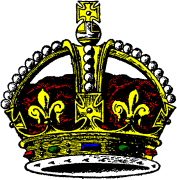 |
| FIG. 642.--Royal Crown. |
"This beautiful piece of jewellery was made by Roundell & Bridge in 1838. Many of the gems in it are old ones reset, and many of them are new. The entire weight of the crown is 39 ozs. 5 dwts. It consists of a circlet of open work in silver, bearing in the front the great sapphire from the crown of Charles II. which was bequeathed to George III. by Cardinal York, with other Stuart treasure. At one end this gem is partly pierced. It is not a thick stone, but it is a fine colour. Opposite to the large sapphire is one of smaller size. The remainder of the rim is filled in with rich jewel clusters having alternately sapphires and emeralds in their centres, enclosed in ornamental borders thickly set with diamonds. These clusters are separated from each other by trefoil designs also thickly set with diamonds. The rim is bordered above and below
with bands of large pearls, 129 in the lower row, and 112 in the upper. [The crown as remade for King Edward VII. now has 139 pearls in the lower row, and 122 in the upper.] Above the rim are shallow festoons of diamonds caught up between the larger ornaments by points of emeralds encircled with diamonds, and a large pearl above each. On these festoons are set alternately eight crosses-patée, and eight fleurs-de-lis of silver set with gems. The crosses-patée are thickly set with brilliants, and have each an emerald in the centre, except that in front of the crown, which contains the most remarkable jewel belonging to the regalia. This is a large spinal ruby of irregular drop-like form, measuring about 2 ins. in length, and is highly polished on what is probably its natural surface, or nearly so. Its irregular outline makes it possible to recognise the place that it has formerly occupied in the older
State crowns, and it seems always to have been given the place of honour. It is pierced after an Oriental fashion, and the top of the piercing is filled with a supplementary ruby set in gold. Don Pedro, King of Castille in 1367, murdered the King of Granada for the sake of his jewels, one of which was this stone, and Don Pedro is said to have given it to Edward the Black Prince after the battle of Najera, near Vittoria, in the same year. After this, it is said to have been worn by Henry V. in his crown at Agincourt in 1415, when it is recorded that the King's life was saved from the attack of the Due D'Alençon, because of the protection afforded him by his crown, a portion of which, however, was broken off. It may be confidently predicted that such a risk of destruction is not very likely to happen again to the great ruby.
"In the centre of each of the very ornamental fleurs-de-lis is a ruby, and all the rest of the ornamentation on them is composed of rose diamonds, large and small. From each of the crosses-patée, the upper corners of which have each a large pearl upon them, rises an arch of silver worked into a design of oak-leaves and acorn-cups. These leaves and cups are all closely encrusted with a mass of large and small diamonds, rose brilliant, and table-cut; the acorns themselves formed of beautiful drop-shaped pearls of large size. From the four points of intersection of the arches at the top of the crown depend large egg-shaped pearls. From the centre of the arches, which slope slightly downwards, springs a mound with a
cross-patée above it. The mound is ornamented all over with close lines of brilliant diamonds, and the fillet which encircles it, and the arch which crosses over it, are both ornamented with one line of large rose-cut diamonds set closely together. The cross-patée at the top has in the centre a large sapphire of magnificent colour set openly. The outer lines of the arms of the cross are marked by a row of small diamonds close together and in the centre of each arm is a large diamond, the remaining spaces being filled with more small diamonds. The large sapphire in the centre of this cross is said to have come out of the ring of Edward the Confessor, which was buried with him in his shrine at Westminster, and the possession of it is supposed to give to the owner the power of curing the cramp. If this be indeed the stone which
belonged to St. Edward, it was probably recut in its present form of a 'rose' for Charles II., even if not since his time.
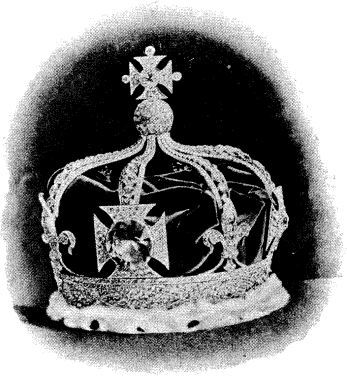 |
| FIG. 643.--Queen Alexandra's Coronation Crown. |
"Not counting the large ruby or the large sapphire, this crown contains: Four rubies, eleven emeralds, sixteen sapphires, 277 pearls, 2783 diamonds. [As remade for King Edward VII. the crown now has 297 pearls and 2818 diamonds.]
"The large ruby has been valued at £110,000.
"When this crown has to take a journey it is provided with a little casket, lined with white velvet, and having a sliding drawer at the bottom, with a boss on which the crown fits closely, so that it is safe from slipping. The velvet cap turned up with miniver, with which it is worn, is kept with it."
This crown has been recently remade for King Edward VII., but has not been altered in any essential details. The cap of the real crown is of purple velvet.
Fig. 643 represents the crown of the Queen Consort with which Queen Alexandra was crowned on August 9, 1902. It will be noticed that, unlike the King's crowns, this has eight arches. The circlet which forms the base is 1 1/2 inches in height. The crown is entirely composed of diamonds, of which there are 3972, and these are placed so closely together that no metal remains visible. The large diamond visible in the illustration is the famous Koh-i-noor. Resting upon the rim are four crosses-patée, and as many fleurs-de-lis, from each of which springs an arch. As a matter of actual fact the crown was made for use on this one occasion and has since been broken up.
There is yet another crown, probably the one with which we are most familiar. This is a small crown entirely composed of diamonds: and the earliest heraldic use which can be found of it is in the design by Sir Edgar Boehm for the 1887 Jubilee coinage. Though effective enough when worn, it does not, from its small size, lend itself effectively to pictorial representation, and as will be remembered, the design of the 1887 coinage was soon abandoned. This crown was made at the personal expense of Queen Victoria, and under her instructions, owing to the fact that her late Majesty found her "State" crown uncomfortable to wear, and too heavy for prolonged or general use. It is understood, also, that the Queen found the regulations concerning its custody both inconvenient and irritating. During the later part of her reign this smaller crown was the only
one Queen Victoria ever wore. By her will the crown was settled as an heirloom upon Queen Alexandra, to devolve upon future Queens Consort for the time being. This being the case, it is not unlikely that in the future this crown may come to be regarded as a part of the national regalia, and it is as well, therefore, to reiterate the remark, that it was made at the personal expense of her late Majesty, and is to no extent and in no way the property of the nation.
CORONETS OF RANK
In spite of various Continental edicts, the heraldic use of coronets of rank, as also their actual use, seems elsewhere than in Great Britain to be governed by no such strict regulations as are laid down and conformed to in this country. For this reason, no less than for the greater interest these must necessarily possess for readers in this country, English coronets will first claim our attention. It has been already observed that coronets or jewelled fillets are to be found upon the helmets even of simple knights from the earliest periods. They probably served no more than decorative purposes, unless these fillets be merely turbans, or suggestions thereof. As late as the fifteenth century there appears to have been no regularised form, as will be seen from Fig. 644, which represents the coronet as shown upon
the effigy of Thomas FitzAlan, Earl of Arundel, in Arundel Church (1415). A very similar coronet surmounts the head-dress of the effigy of Beatrice, Countess of Arundel, at the same period. In his will, Lionel, Duke of Clarence (1368), bequeaths "two golden circles," with one of which he was created Duke. It is of interest to compare this with Fig. 645, which represents the crown of King Henry IV. as represented on his effigy. Richard, Earl of Arundel, in his will (December 5, 1375), leaves his "melieure coronne" to his eldest son Richard, his "second melieure coronne" to his daughter Joan, and his "tierce coronne" to his daughter Alice. Though not definite proof of the point, the fact that the earl distributes his coronets amongst his family irrespective of the fact that the earldom (of which one would presume the coronets to be a sign) would pass to his son, would seem
to show that the wearing of a coronet even at that date was merely indicative of high nobility of birth, and not of the possession of a substantive Parliamentary peerage. In spite of the variations in form, coronets were, however, a necessity. When both dukes and earls were created they were invested with a coronet in open Parliament. As time went on the coronet, however, gradually came to be considered the sign of the possession of a peerage, and was so borne; but it was not until the reign of Charles II. that coronets were definitely assigned by Royal Warrant (February 19, 1660) to peers not of the Blood Royal. Before this date a coronet had not (as has been already stated) been used heraldically or in fact by barons, who, both in armorial paintings and in Parliament, had used a plain crimson cap turned
up with white fur.
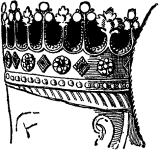 |
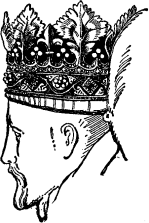 |
| FIG. 644.--Coronet of Thomas FitzAlan, Earl of Arundel. (From his monument in Arundel Church, 1415.) |
FIG. 645.--Crown of King Henry IV. (1399-1413). (From his monument in Trinity Chapel, Canterbury Cathedral.) |
The coronet of the Prince of Wales is exactly like the official (St. Edward's) crown, except that instead of two intersecting arches it has only one. An illustration of this is given in Fig. 646 (this being the usual form in which it is heraldically depicted). It should be noticed, however, that this coronet belongs to the prince as eldest son of the Sovereign and heir-apparent to the Throne, and not as Prince of Wales. It was assigned by Royal Warrant 9th February, 13 Charles II. The coronet of the Princess of Wales, as such, is heraldically the same as that of her husband.
The coronets of the sons and daughters or brothers and sisters of a sovereign of Great Britain (other than a Prince of Wales) is as in Fig. 647, that is, the circlet being identical with that of the Royal Crown, and of the Prince of Wales' coronet, but without the arch. This was also assigned in the warrant of 9th February, 13 Charles II. Officially this coronet is described as being composed of crosses-patée and fleurs-de-lis alternately.
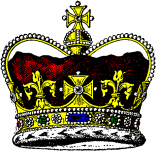 |
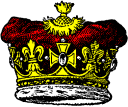 |
| FIG. 646.--Coronet of the Prince of Wales. |
FIG. 647.--Coronet of the younger children of the Sovereign. |
The grandchildren of a sovereign being sons and daughters of the Prince of Wales, or of other sons of the sovereign, have a coronet in which strawberry leaves are substituted for the two outer crosses-patée appearing at the edges of the coronet, which is officially described as composed of crossespatée, fleurs-de-lis, and strawberry leaves.
Princes of the English Royal Family, being sons of younger sons of a sovereign, or else nephews of a sovereign being sons of brothers of a sovereign, and having the rank and title of a duke of the United Kingdom, have a coronet composed alternately of crosses-patée and strawberry leaves, the latter taking the place of the fleurs-de-lis upon the circlet of the Royal Crown. This coronet was also assigned in the warrant of 9th February, 13 Charles II.
It will be observed by those who compare one heraldic book with another that I have quoted these rules differently from any other work upon the subject. A moment's thought, however, must convince any one of the accuracy of my version. It is a cardinal rule of armory that save for the single circumstance of attainder no man's armorial insignia shall be degraded. Whilst any man's status may be increased, it cannot be lessened. Most heraldic books quote the coronet of crosses-patée, fleurs-de-lis, and strawberry leaves as the coronet of the "grandsons" of the sovereign, whilst the coronet of crosses-patée and strawberry leaves is stated to be the coronet of "nephews" or cousins of the sovereign. Such a state of affairs would be intolerable, because it would mean the
liability at any moment to be degraded to the use of a less honourable coronet. Take, for example, the case of Prince Arthur of Connaught. During the lifetime of Queen Victoria, as a grandson of the sovereign he would be entitled to the former, whereas as soon as King Edward ascended the throne he would have been forced to relinquish it in favour of the more remote form.
The real truth is that the members of the Royal Family do not inherit these coronets as a matter of course. They technically and in fact have no coronets until these have been assigned by Royal Warrant with the arms. When such warrants are issued, the coronets assigned have up to the present time conformed to the above rules. I am not sure that the "rules" now exist in any more potent form than that up to the present time those particular patterns happen to have been assigned in the circumstances stated. But the warrants(though they contain no hereditary limitation) certainly contain no clause limiting their operation to the lifetime of the then sovereign, which they certainly would do if the coronet only existed whilst the particular relationship continued.
The terms "grandson of the sovereign" and "nephew of the sovereign," which are usually employed, are not correct. The coronets only apply to the children of princes. The children of princesses, who are undoubtedly included in the terms "grandson" and "nephew," are not technically members of the Royal Family, nor do they inherit either rank or coronet from their mothers.
By a curious fatality there has never, since these Royal coronets were differentiated, been any male descendant of an English sovereign more remotely related than a nephew, with the exception of the Dukes of Cumberland. Their succession to the throne of Hanover renders them useless as a precedent, inasmuch as their right to arms and coronet must be derived from Hanover and its laws, and not from this country. The Princess Frederica of Hanover, however, uses an English coronet and the Royal Arms of England, presumably preferring her status as a princess of this country to whatever de jure Hanoverian status might be claimed. It is much to be wished that a Royal Warrant should be issued to her which would decide the point--at present in doubt--as to what degree of relationship the coronet of the crosses-patée and strawberry leaves is available for, or failing that coronet what the coronet of prince or princess of this country might be, he or she not being child, grandchild, or nephew or niece of a sovereign.
The unique use of actual coronets in England at the occasion of each coronation ceremony has prevented them becoming (as in so many other countries) mere pictured heraldic details. Consequently the instructions concerning them which are issued prior to each coronation will be of interest. The following is from the London Gazette of October 1, 1901:--
"EARL MARSHAL'S OFFICE,
NORFOLK HOUSE, ST. JAMES'S SQUARE, S.W.,
October 1, 1901.
"The Earl Marshal's Order concerning the Robes, Coronets, &c., which are to be worn by the Peers at the Coronation of Their Most Sacred Majesties King Edward the Seventh and Queen Alexandra.
"These are to give notice to all Peers who attend at the Coronation of Their Majesties, that the robe or mantle of the Peers be of crimson velvet, edged with miniver, the cape furred with miniver pure, and powdered with bars or rows of ermine (i.e. narrow pieces of black fur), according to their degree, viz.:
"Barons, two rows.
"Viscounts, two rows and a half.
"Earls, three rows.
"Marquesses, three rows and a half.
"Dukes, four rows.
"The said mantles or robes to be worn over full Court dress, uniform, or regimentals.
"The coronets to be of silver-gilt; the caps of crimson velvet turned up with ermine, with a gold tassel on the top; and no jewels or precious stones are to be set or used in the coronets, or counterfeit pearls instead of silver balls.
"The coronet of a Baron to have, on the circle or rim, six silver balls at equal distances.
"The coronet of a Viscount to have, on the circle, sixteen silver balls.
"The coronet of an Earl to have, on the circle, eight silver balls, raised upon points, with gold strawberry leaves between the points.
"The coronet of a Marquess to have, on the circle, four gold strawberry leaves and four silver balls alternately, the latter a little raised on points above the rim.
"The coronet of a Duke to have, on the circle, eight gold strawberry leaves.
"By His Majesty's Command,
"NORFOLK, Earl Marshal."
"EARL MARSHAL'S OFFICE,
NORFOLK HOUSE, ST. JAMES'S SQUARE, S.W.,
October 1, 1901.
"The Earl Marshal's Order concerning the Robes, Coronets, &c., which are to be worn by the Peeresses at the Coronation of Their Most Sacred Majesties King Edward the Seventh and Queen Alexandra.
"These are to give notice to all Peeresses who attend at the Coronation of Their Majesties, that the robes or mantles appertaining to their respective ranks are to be worn over the usual full Court dress.
"That the robe or mantle of a Baroness be of crimson velvet, the cape whereof to be furred with miniver pure, and powdered with two bars or rows of ermine (i.e. narrow pieces of black fur); the said mantle to be edged round with miniver pure 2 inches in breadth, and the train to be 3 feet on the ground; the coronet to be according to her degree--viz. a rim or circle with six pearls (represented by silver balls) upon the same, not raised upon points.
"That the robe or mantle of a Viscountess be like that of a Baroness, only the cape powdered with two rows and a half of ermine, the edging of the mantle 2 inches as before, and the train 1 1/4 yards; the coronet to be according to her degree--viz. a rim or circle with pearls (represented by silver balls) thereon, sixteen in number, and not raised upon points.
"That the robe or mantle of a Countess be as before, only the cape powdered with three rows of ermine, the edging 3 inches in breadth, and the train 1 1/2 yards; the coronet to be composed of eight pearls (represented by silver balls) raised upon points or rays, with small strawberry leaves between, above the rim.
"That the robe or mantle of a Marchioness be as before, only the cape powdered with three rows and a half of ermine, the edging 4 inches in breadth, the train 1 3/4 yards; the coronet to be composed of four strawberry leaves and four pearls (represented by silver balls) raised upon points of the same height as the leaves, alternately, above the rim.
"That the robe or mantle of a Duchess be as before, only the cape powdered with four rows of ermine, the edging 5 inches broad, the train 2 yards; the coronet to be composed of eight strawberry leaves, all of equal height, above the rim.
"And that the caps of all the said coronets be of crimson velvet, turned up with ermine, with a tassel of gold on the top.
"By His Majesty's Command,
"NORFOLK, Earl Marshal."
The Coronation Robe of a peer is not identical with his Parliamentary Robe of Estate. This latter is of fine scarlet cloth, lined with taffeta. The distinction between the degrees of rank is effected by the guards or bands of fur. The robe of a duke has four guards of ermine at equal distances, with gold lace above each guard and tied up to the left shoulder by a white riband. The robe of a marquess has four guards of ermine on the right side, and three on the left, with gold lace above each guard and tied up to the left shoulder by a white riband. An earl's robe has three guards of ermine and gold lace. The robes of a viscount and baron are identical, each having two guards of plain white fur.
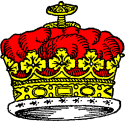 |
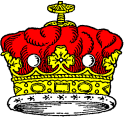 |
| FIG. 648. |
FIG. 649. |
By virtue of various warrants of Earls Marshal, duly recorded in the College of Arms, the use or display of a coronet of rank by any person other than a peer is stringently forbidden. This rule, unfortunately, is too often ignored by many eldest sons of peers, who use peerage titles by courtesy.
The heraldic representations of these coronets of rank are as follows:--
The coronet of a duke shows five strawberry leaves (Fig. 648). This coronet should not be confused with the ducal crest coronet.
The coronet of a marquess shows two balls of silver technically known as "pearls," and three strawberry leaves (Fig. 649).
The coronet of an earl shows five "pearls" raised on tall spikes, alternating with four strawberry leaves (Fig. 650).
The coronet of a viscount shows nine "pearls," all set closely together, directly upon the circlet (Fig. 651).
The coronet of a baron shows four "pearls" upon the circlet(Fig. 652). This coronet was assigned by Royal Warrant, dated 7th August, 12 Charles II., to Barons of England, and to Barons of Ireland by warrant 16th May, 5 James II.
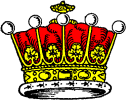 |
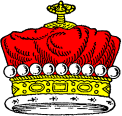 |
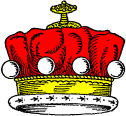 |
| FIG. 650. |
FIG. 651. |
FIG. 652. |
All coronets of degree actually, and are usually represented to, enclose a cap of crimson velvet, turned up with ermine. None of them are permitted to be jewelled, but the coronet of a duke, marquess, earl, or viscount is chased in the form of jewels. In recent times, however, it has become very usual for peers to use, heraldically, for more informal purposes a representation of the circlet only, omitting the cap and the ermine edging.
 |
| FIG. 653.--The Crown of a King of Arms. |
The crown or coronet of a king of arms (Fig. 653) is of silver-gilt formed of a circlet, upon which is inscribed part of the first verse of the 51st Psalm, viz.: "Miserere mei Deus secundum magnam misericordiam tuam." The rim is surmounted with sixteen leaves, in shape resembling the oak-leaf, every alternate one being somewhat higher than the rest, nine of which appear in the profile view of it or in heraldic representations. The cap is of crimson satin, closed at the top by a gold tassel and turned up with ermine.
Anciently, the crown of Lyon King of Arms was, in shape, an exact replica of the crown of the King of Scotland, the only difference being that it was not jewelled.
Coronets of rank are used very indiscriminately on the Continent, particularly in France and the Low Countries. Their use by no means implies the same as with us, and frequently indicates little if anything beyond mere "noble" birth.
The Mauerkrone [mural crown] (Fig. 654) is used in Germany principally as an adornment to the arms of towns. It is borne with three, four, or five battlemented towers. The tincture, likewise, is not always the same: gold, silver, red, or the natural colour of a wall being variously employed. Residential [i.e. having a royal residence] and capital towns usually bear a Mauerkrone with five towers, large towns one with four towers, smaller towns one with three. Strict regulations in the matter do not yet exist. It should be carefully noted that this practice is peculiar to Germany and is quite incorrect in Great Britain.
 |
 |
| FIG. 654.--Mauerkrone. |
FIG. 655.--Naval crown. |
The Naval Crown[Schiffskrone] (Fig. 655), on the circlet of which sails and sterns of ships are alternately introduced, is very rarely used on the Continent. With us it appears as a charge in the arms of the towns of Chatham, Ramsgate, Devonport, &c. The Naval Coronet, however, is more properly a crest coronet, and as such will be more fully considered in the next chapter. It had, however, a limited use as a coronet of rank at one time, inasmuch as the admirals of the United Provinces of the Netherlands placed a crown composed of prows of ships above their escutcheons, as may be seen from various monuments.
XXII
1
2
3
4
5
6
7
8
9
10
11
12
13
14
15
16
17
18
19
20
21
22
23
24
25
26
27
28
29
30
31
32
33
34
35
36
37
38
39
40
41
42
Introduction
Index
HOME
Build: 2012/06/26 06:24:19.53+0900(JST)



























 published in 1830(Fig.
640).
published in 1830(Fig.
640).













